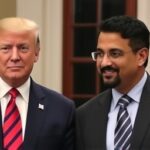In a stunning turn of events that has captivated the nation, President Donald Trump and New York City Mayor-elect Zohran Mamdani emerged from a private White House meeting with vows of collaboration, marking a rare display of bipartisanship amid deep political divides. The encounter, held in the Oval Office on a crisp autumn morning, transformed months of heated campaign rhetoric into promises of joint action on pressing economic and urban challenges facing New York City.
The meeting, which lasted over two hours and was partially broadcast live on major networks, showcased an unexpected warmth between the two leaders. Trump, known for his unyielding stance on urban policy, praised Mamdani’s “fresh vision for the Big Apple,” while the mayor-elect reciprocated by acknowledging Trump‘s “decades of business acumen that could revitalize our streets.” This pledge comes at a pivotal moment, as Mamdani prepares to take office in January, inheriting a city grappling with post-pandemic recovery, housing shortages, and infrastructure woes.
Observers hailed the summit as a potential turning point in federal-local relations, especially given the stark ideological differences between Trump’s Republican administration and Mamdani’s progressive Democratic platform. During the campaign, Mamdani had criticized Trump’s policies on immigration and policing as detrimental to New York City’s diverse communities, while Trump labeled Mamdani a “radical socialist” in rally speeches. Yet, in a dramatic pivot, both leaders set aside these hostilities, focusing instead on shared goals like job creation and affordable housing.
From Bitter Campaign Feud to Oval Office Unity
The path to this White House meeting was anything but smooth. Zohran Mamdani, a 32-year-old state assemblyman of Ugandan-Indian descent, surged to victory in New York City’s mayoral race on a platform emphasizing equity, green energy, and police reform. His campaign drew sharp rebukes from Trump, who tweeted repeatedly about Mamdani’s “anti-business agenda that would bankrupt the greatest city in the world.” Mamdani fired back, accusing Trump of neglecting urban America during his presidency, particularly in funding for public transit and small businesses.
Despite the barbs, behind-the-scenes diplomacy paved the way for reconciliation. Sources close to the administration revealed that Trump’s advisors, including Commerce Secretary Wilbur Ross, initiated contact weeks before the election, emphasizing the mutual benefits of federal support for New York City. Mamdani, in a post-meeting press conference, credited his transition team for “finding common ground beyond party lines.”
The symbolism of the venue—the White House—amplified the event’s impact. As the two entered the Oval Office, flanked by aides and under the watchful eyes of Secret Service agents, the air was thick with anticipation. Trump greeted Mamdani with a firm handshake, quipping, “Zohran, you beat the odds in that race—now let’s beat the odds together for New York.” Mamdani responded, “Mr. President, New York City is America’s heartbeat; your partnership could make it stronger than ever.”
This exchange, captured on video, quickly went viral, amassing over 10 million views within hours. Social media buzzed with reactions, from skeptics questioning the sincerity to optimists celebrating a model of bipartisanship. Political historian Dr. Elena Vasquez noted, “In an era of gridlock, this meeting echoes the bipartisan spirit of past administrations, like Reagan and Koch in the 1980s, but with modern stakes.”
New York City’s Economic Pressures Take Center Stage
At the heart of the discussions were New York City’s most urgent economic issues. The metropolis, home to 8.8 million residents, has faced a 15% unemployment spike since the COVID-19 pandemic, with small businesses shuttering at an alarming rate—over 5,000 in Manhattan alone last year, according to city comptroller data. Trump highlighted his administration’s infrastructure initiatives, pledging to fast-track $2 billion in federal grants for subway upgrades and broadband expansion in underserved neighborhoods.
Mamdani, whose campaign promised a “Green New York Deal,” pushed for sustainable investments. He outlined plans to create 50,000 green jobs through retrofitting buildings for energy efficiency, seeking White House backing to leverage private sector involvement. “New York City can’t thrive in isolation,” Mamdani stated during the meeting. “We need federal resources to turn our climate ambitions into economic reality.”
Trump, drawing from his real estate background, emphasized deregulation to spur development. He proposed easing environmental reviews for major projects, a move that could accelerate construction of affordable housing units—a critical need with the city’s vacancy rate hovering at just 3%. Statistics from the U.S. Census Bureau underscore the crisis: over 100,000 New Yorkers experienced homelessness in 2023, a 20% increase from pre-pandemic levels.
The leaders also touched on tourism recovery, a sector that generated $70 billion annually pre-COVID but has yet to rebound fully. Trump touted tax incentives for hotels and attractions, while Mamdani advocated for worker protections to ensure fair wages in the industry. Their joint commitment: a task force co-chaired by representatives from both sides to report progress within six months.
- Federal Funding Boost: Trump announced an immediate review of $500 million in untapped HUD funds for New York City revitalization.
- Job Training Partnerships: Collaboration on apprenticeships in tech and construction, targeting 20,000 positions for underserved youth.
- Infrastructure Timeline: Accelerated permitting for the Gateway Tunnel project, vital for commuter rail between New York and New Jersey.
These specifics reflect a pragmatic approach, blending Trump’s pro-growth ethos with Mamdani’s equity focus, potentially setting a template for other cities.
Bipartisanship in Action: Quotes and Key Agreements
The White House meeting wasn’t just optics; it yielded tangible agreements that underscore bipartisanship. In a joint statement released post-summit, Trump and Mamdani outlined priorities including tax reforms to attract businesses back to New York City and enhanced security measures for subways following recent crime upticks—violent incidents rose 12% in 2023 per NYPD reports.
Trump elaborated on his vision: “I’ve always said New York is my city. Zohran gets it—bureaucracy kills dreams. Together, we’ll cut the red tape and bring back the boom.” Mamdani, balancing his progressive roots, added, “This isn’t about left or right; it’s about lifting up every New Yorker, from Wall Street to the outer boroughs. Bipartisanship means results, not rhetoric.”
Notable concessions emerged: Trump agreed to support Mamdani’s push for expanded federal aid to public schools, allocating $300 million for STEM programs in high-poverty districts. In return, Mamdani endorsed Trump’s trade policies aimed at protecting manufacturing jobs in the Bronx and Queens, where factory closures have displaced thousands.
Experts like urban policy analyst Marcus Hale from the Brookings Institution praised the dialogue. “This level of detail in a first meeting is unprecedented,” Hale said. “It signals genuine intent, especially on urban issues where federal dollars can make or break a mayor’s term.”
Challenges remain, however. Labor unions, a key Mamdani constituency, expressed wariness over deregulation fears, while Trump’s base questioned cozying up to a Democrat. Yet, the meeting’s tone suggested both leaders are prioritizing governance over partisanship.
Reactions Pour In from City Hall to Capitol Hill
The summit rippled across political landscapes, eliciting a spectrum of responses. In New York City, incoming deputy mayors and council members lauded the outreach. Council Speaker Adrienne Adams tweeted, “Mayor-elect Mamdani’s diplomacy could unlock billions for our schools and streets— a win for bipartisanship.”
On the federal level, Senate Minority Leader Chuck Schumer, a New York Democrat, called it “a step forward, though vigilance is needed on progressive priorities.” Republicans, including House Speaker Kevin McCarthy, welcomed the overture, with McCarthy stating, “President Trump’s leadership shows how to bridge divides for American cities.”
Civic groups weighed in heavily. The New York Civil Liberties Union commended the focus on equitable development but urged safeguards for immigrant communities. Business leaders from the Partnership for New York City, representing Fortune 500 firms, projected that collaborative policies could add 100,000 jobs by 2026, citing models from Trump’s tax cuts and Mamdani’s innovation hubs.
Public opinion polls conducted immediately after the meeting by Quinnipiac University showed 62% approval among New Yorkers, with 55% nationwide viewing it positively—a rare bipartisan bright spot. Social media trends like #TrumpMamdaniPact trended globally, amplifying the story’s reach.
Critics, including progressive activists, voiced concerns. “Bipartisanship can’t mean compromising on justice,” said organizer Lila Patel of the NYC Justice Coalition. Nonetheless, the overall sentiment leaned optimistic, with many seeing it as a blueprint for national healing.
Charting the Path Forward for Federal-City Partnerships
Looking ahead, the Trump-Mamdani alliance promises to reshape federal engagement with New York City. Follow-up meetings are scheduled quarterly, starting with a joint economic summit in January at City Hall. Key initiatives include piloting a public-private fund for affordable housing, aiming to build 10,000 units in the next two years, and integrating AI-driven traffic management to reduce congestion costs, estimated at $20 billion annually by city planners.
Broader implications extend beyond New York. Other mayors, from Los Angeles to Chicago, have inquired about similar White House access, hinting at a wave of urban-federal collaborations. Trump hinted at expanding this model, saying, “If it works for the Big Apple, it’ll work everywhere.” Mamdani echoed, “This is just the beginning—sustainable, inclusive growth starts with dialogue.”
As implementation unfolds, metrics for success will be crucial. Independent auditors from the Government Accountability Office will monitor fund allocations, ensuring transparency. For New Yorkers, the real test lies in tangible improvements: shorter commutes, more jobs, safer streets. If the pledges hold, this White House meeting could be remembered as the spark that reignited America’s urban renaissance, fostering bipartisanship in an otherwise polarized era.









